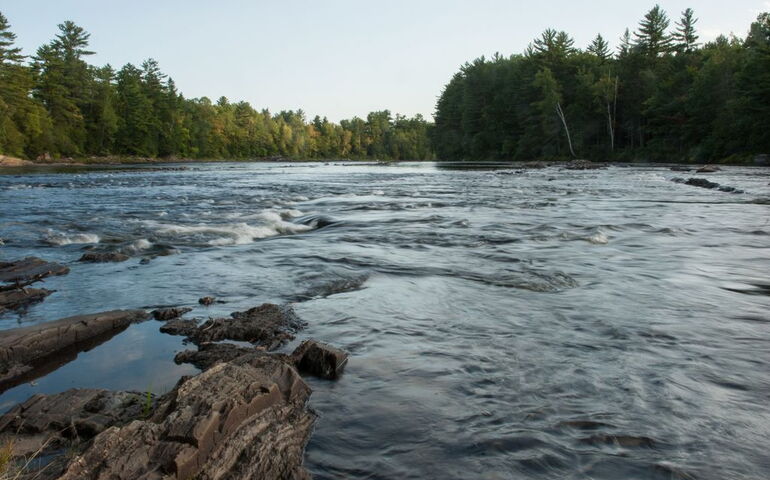
Take me to the river: Talking Head David Byrne talks about dam removal in Maine
 File Photo / James McCarthy
A view of the East Branch of the Penobscot River near the Katahdin Woods and Waters National Monument, shown in a 2017 file photo.
File Photo / James McCarthy
A view of the East Branch of the Penobscot River near the Katahdin Woods and Waters National Monument, shown in a 2017 file photo.
David Byrne might be the last person you'd expect to find in Waterville on a Saturday night, discussing the economic impact of dam removals along the Penobscot River.
But there he was on March 30, at the Waterville Opera House — the musician-artist-writer-actor-producer himself. Co-founder and frontman of legendary post-punk band Talking Heads. Quirky, inventive virtuoso, winner of a Grammy and a Golden Globe, an Oscar and a Tony.
Byrne, now 71, also publishes online magazine Reasons to Be Cheerful, which provides exactly that, or as it describes, inspirational stories of "smart, proven, replicable solutions to the world’s most pressing problems."

One reason for such positivity is the undamming of Maine's Penobscot River, according to the nonprofit zine, which has 130,000 subscribers. Byrne said its Dec. 11 feature on the river restoration was the most popular story of 2023.
"It touched people," Byrne told a capacity crowd of 800 on Saturday. "And we said, 'We've written about this. So, can we do what we're doing now and talk to people, tell you how [the restoration project] did this and why it matters?'"
'Ancestral mandate'
Wearing a blue zip-up vest and at times peering through a set of glasses, Byrne little resembled the star who sported a grotesquely oversized gray suit in the '80s and a tailored one more recently.
Instead, Byrne — who was born in Scotland and grew up in suburban Baltimore — looked something like, well, a Mainer.
As he recounted the story of the Penobscot River's restoration, he shared the stage with three actual Mainers who were part of the comeback: Chief Kirk Francis of the Penobscot Nation, the indigenous people for whom the river is a sacred ancestral home; John Banks, a member of the tribe and formerly its director of natural resources; and Laura Rose Day, who served as executive director of the Penobscot River Restoration Trust.
The restoration work, completed in 2016, struck a tricky balance between rejuvenating wild fisheries and maintaining hydroelectricity production on Maine's largest river system. Including its branches, the Penobscot runs 264 miles between Mt. Katahdin and Penobscot Bay.
After nearly two centuries of being dammed and diverted for use by paper mills and energy producers, the river was in poor environmental health. Because dams typically block the travel of spawning fish species, their stocks had dwindled. Parts of the Penobscot were stagnant, polluted and almost lifeless.
"I grew up at a time when the river was sick, and we knew it was long before science confirmed that," said Francis. Healing the Penobscot, he said, was "an ancestral mandate."
"We don't look at the river as a body of water, but as a relative, and someone we have to take care of."
As part of that duty, the Penobscot Nation came together with a variety of environmental groups in the 1990s to fight Bangor Hydro Electric Co.'s proposed addition of a hydropower dam, known as the Basin Mills project.
"We mounted a campaign to oppose this dam, and it was never built," said Banks. "What came out of those discussions was a group of people, including the tribe and conservation groups, who said, 'What can we do next?'"
A coalition, the Penobscot River Restoration Trust, was formed in 1999. Over the next 17 years, the trust acquired three Penobscot River dams, dismantled two of them, created a bypass around the other, and restored 2,000 miles of habitat for sea-run fish.
The effort required a complex mix of real estate deals, grassroots advocacy with municipalities, and lobbying with federal and state regulators. The trust also had to negotiate with PPL Corp., the company that had purchased the dams from Bangor Hydro, now part of Versant Power. Ultimately, PPL was able to renovate and relicense six smaller dams, so that it could continue generating hydropower at roughly the same level.
All in, the cost of project through public and private funding: $63 million.
Economic upside
It's not unusual for Byrne or his publication to support environmental conservation efforts. The cheerfulness rationale is full of them; in addition to the story of the Penobscot River restoration, RTBC reported at least twice last year on dam mitigation.
Byrne told a story of his own experience dealing with dams as a teenager, with friends on a rafting trip in West Virginia.
"There was a dam. The banks were muddy, and the river just stopped and felt kind of dead," he said. The crew carried their craft around the obstacle, and resumed their journey.
"Then lo and behold, there was another dam," Byrne said. "This went on and on until we just gave up. This was not fun. For me, it was a lifelong lesson in what dams can do. It was a visceral effect."
On Saturday, however, Byrne considered another perspective.
"Let me play devil's advocate," he said. "Let's understand why this is a good thing. Don't we need dams for hydropower, for flood control, for recreation?"
"Yes," said Day, "but we certainly don't need all of them." Some dams are essential, she admitted. Others are obsolete, unused or in disrepair. At still other sites, the removal of a single dam can have a far-reaching upside that surpasses potential drawbacks.
"Each situation has to be looked at independently, and the benefits and disadvantages weighed."
"So what is the economic benefit when a dam is removed?" Byrne asked.
Francis gave two examples. Since dams have been cleared from the Penobscot River, it has been the site of several whitewater rafting championships that have brought "hundreds of people" to the Old Town area, he said. There's also been business growth for Maine guides.
"The economic impact is still a little bit unclear, but I do know there's more industry for nature-based tourism," he said. "That was just not possible before."
Byrne also summarized the findings of studies showing that dam removal in some parts of the country has led to greater local prosperity.
"There is job creation when dams are removed," he said. "And when dams are gone and a river is flowing again, houses near it become more valuable."














0 Comments